Evergreen's Fitness for the Four Seasons by Dr. Julia Evergreen KeeferEvergreen's Fitness for the Four Seasons by 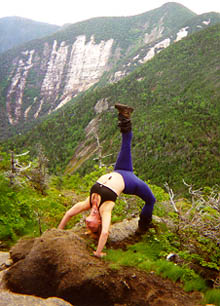 Dr. Julia Evergreen Keefer julia.keefer@nyu.edu
Dr. Julia Evergreen Keefer julia.keefer@nyu.edu
Part Two: Sultry, Sizzling Summer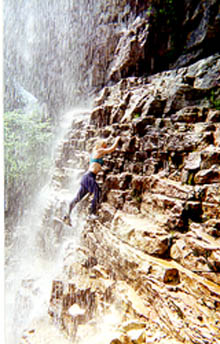
Ch07: Aerobic Activity: Climb Every Mountain
From stair climbing, to step aerobics, to climbing mountains, your butt doesn't have to sag with the summer!
Climb Every Mountain
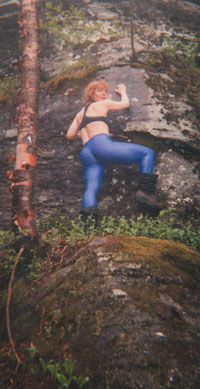
Elevators or Stairs?
I hate the claustrophobic feeling of an elevator where people are squished together like insects. Every time I see stairs, or a step class or DVD, or a mountain, I think how it will sculpt my buttocks and work my heart. Even when I am kickboxing, taking ballet, body building and doing triathlons, I don't get the special roundness in the butt you get from stair climbing. The elliptical isn't the same. You don’t have to take the stairs every day. Just like any other exercise, you need a day off. You also need to cross-train. I never climb the 38 flights to the health club more than twice a week.
Biomechanical Tips
Going Up
Every Monday morning I climb 38 flights of stairs to the health club where I teach Knockout Step/Slide/Strike™. I lead with my heels, keep my butt back and my legs in parallel, and put my hands on the railings so that I can squeeze my lats as I push down, getting an upper body workout as well. Keep your buttocks as far back as you can, contracting them strongly as if you were doing a squat. This will prevent your knees from flexing more than ninety degrees.
Coming Down
I don’t go down as many stairs--sometimes only 11, because that can be harder on the knees. When going downstairs, turn the hips out slightly and use your feet muscles to cushion the impact on your knees. Point your foot as soon as it leaves the step and then land on the ball of your foot and roll to your heel as you transfer your weight. Keep your pelvis back to contract your buttocks and prevent the knee from flexing more than ninety degrees. However, when climbing down a mountain you may have to hyperextend your toes in order to avoid tripping.
It is possible to go up and downstairs sideways, if the forward motion hurts too much. This can be useful after an ACL tear.
Stairs Sprints
Level III can run up and down, two or more at a time, as long as you don’t over-flex the knee, or irritate your joints
Stair Boot Camp
Use the stairs for incline/decline pushups, by putting your hands and feet on upper or lower stairs, dips near the landing, one-legged squats, calf raises, and lunges. Then wash your hands!
Step-ups in the Park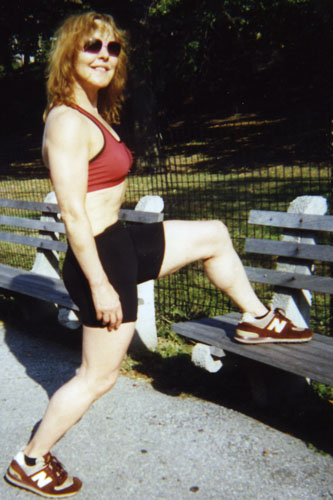
The park bench is a challenging step. 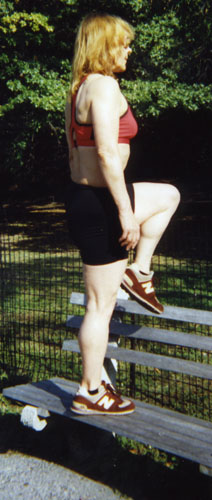 Do side steps, knee and leg lifts.
Do side steps, knee and leg lifts. 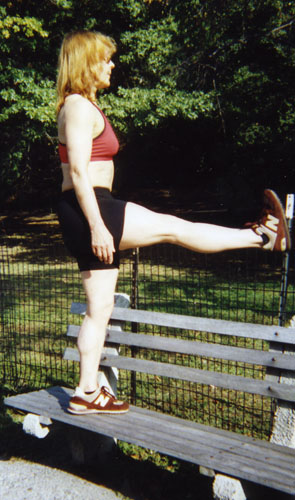
Hiking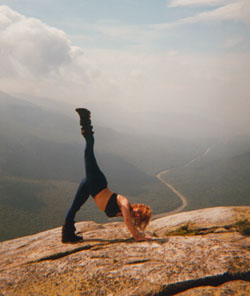
Hiking is one of my favorite outdoor sports. It is free, or moderately priced, and a wonderful way to work your legs and back and heart while communing with nature. I have hiked in the Sierras, the Rockies, Colorado, all over the Northeast, in Morocco, France, Turkey, and Egypt. However, I have also had high altitude pulmonary edema from doing too much too fast climbing over 14,000 feet, hyperthermia from getting chilled and glycogen-depleted during Adirondack rains, 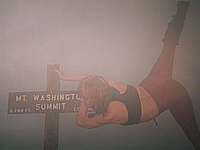 shock from getting stuck in an avalanche in the French alps, and Lyme disease from ticks in the Northeast. Take precautions. Check for ticks and adverse weather conditions. Drink lots of water, and eat regularly and plentifully. What is left of the wilderness is our most beautiful treasure.
shock from getting stuck in an avalanche in the French alps, and Lyme disease from ticks in the Northeast. Take precautions. Check for ticks and adverse weather conditions. Drink lots of water, and eat regularly and plentifully. What is left of the wilderness is our most beautiful treasure.
Using Poles
Poles can be used for hiking as well as skiing. They add an upper body workout as you push down with your lats and triceps. They help you balance. When you go downhill, poles can take some of the pressure off those quad muscles.
Rock Scrambling and Climbing
Leave your poles at home if you want to rock scramble or climb. Some of the best rock scrambling is in the High Peaks of the Adirondacks or the Whites of New Hampshire. In scrambling, you work out your core muscles, your arms and your legs as you scramble over butt-building boulders and climb up crevices.The closest short rock scramble from Manhattan is Breakneck Ridge on the Hudson River, but be careful of Lyme ticks.
Real climbing requires special gear, a team, and lessons. The best rock climbing in the Northeast is at the Mohonk Preserve near New Paltz, 60 miles north of Manhattan.
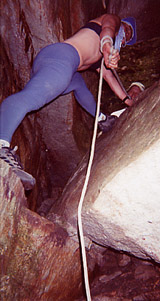

Trail Running
Trail running gives you a soft surface, unlike concrete, but an unstable one, often filled with twigs, rocks, vegetation, or leaves. Make sure you don’t trip. Run on flats and graduated hills and then switch to a scramble to go up the rock.
Step Aerobics
Step Aerobics became popular in the late eighties, and is still one of the best ways to get in shape at home without expensive equipment. You can stuff the step under the bed, in a closet, or behind the bathroom door. Unlike many exercise videos, it is low-impact, so you don’t have to worry about what kind of floor you don’t have. Nothing picks up your butt like a good step workout.
Use proper lifting technique to assemble your step, and make sure it is locked.
It is preferable that you use special aerobics music tapes with clear 32 count phrases so you can do routines to the right and to the left. The recommended BPM is 118 to 126, which is essential for Levels I and II. Level III can go faster once they master the coordination and alignment. During the step craze in New York, many of the health clubs stepped as 145 BPM, but that is contraindicated for the general population, although it will give a great cardio workout to Level III.
Step height should be such that your thigh angle is never less than 90 degrees when weight bearing and that the kneecap points towards the third toe, not the big toe as it bends.
Pain
If your knees hurt while stepping, stop and stretch your quads. Hold on to the wall, bend one knee back. Grab the heel with your hand or a shirt and pull towards your buttocks. Contract your abs and your buttocks, keep your inner thighs pressed together.
Alignment
Review knee alignment in Dr. Keefer's Corrective Clinic. The most serious concerns are knock knees or excessive pronation. It is also important to maintain a neutral pelvic tilt and to bring both sides of the pelvis up and down equally.
Warming up in slow motion to insure good technique is sometimes an excellent way to avoid knee injuries.
In stepping, the Achilles is frequently overworked, not only because the heel goes down in every repeater, but because the instrinsic muscles of the feet and the foot flexors do not carry their share of the work.
There is a tendency to develop forward head placement because of anxiety, step watching (which should be done with the eyes) and/or habitual posture.
Use a variety of arm movements while stepping, not just punches or biceps curls. Let the arms circle backwards, float sideways and reach overhead.
Prance: Don’t schlep over the step. If you are depressed, stepping can be too heavy and cause too much impact on your joints.
Lightness of foot placement is essential. Don’t bang your feet up and down. Do the first few minutes in silence to keep your foot strike light as if you were didn’t want to wake the baby.
Basics, Vs and Turns
Start/Finish Stand a few inches from the step with the feet separated in a parallel position. Put your right foot on the step, then your left. Then come down with your right foot, then your left: up, up, down, down. This is a basic with a right lead. After 8 repetitions change to a left lead.
This basic rhythm can move into a V-step by separating the feet on the step or a turn step by alternating right and left in a quarter turn with a tap to change leads.
You can do this basic rhythm, facing the short end of the step in a straddle position. Up, up, straddle down, straddle down works your lateral muscles more than the front basics.
Over the Top and Across the Top
Generally, “Over the Top” refers to a 4-count 123 tap step over the narrow portion of the step, and “Across the Top” refers to the same step traveling lengthwise across the longer portion of the step. If Across the Top is too difficult for you, substitute with a grapevine on the floor.
Pain
There were many step injuries because advanced people did it too much, and beginners had bad technique. Avoid overuse. Cross-train. Don’t step or do any routine more than two or three times a week.
Leg Lifts in All Directions
Leg lifts can be practiced on the floor first: Step on your right foot, lift your left knee, bring your left foot down, then your right. Then Step on your left foot, lift your right knee, bring your right food down, then your left. You can lift your knee to the front, the side or the back or kick a straight leg front, side or back. Repeaters means you lift the leg two, three, four or five times in any position. Make sure you do the same movement on both sides.
Posture
Keep your spine straight and don’t kick your leg higher than hip level, unless you are Level III.
Lunges
Start by squatting on the step. Then do a one-legged squat, touching the tip of the toe to the floor and return it. Repeat with the other leg. Imagine that the floor is filled with hot water. Go as fast as you like, keeping the squatting leg in good alignment with the knee pointing over the third toe, keeping the buttocks back.
Performance
Step lightly. Don’t pound your joints. Are you making any noise?
As you step up, dorsiflex your foot and then step to the center of the platform. When stepping off, stay fairly close to the platform.
Remember that excessive stepping can cause tightness in the ITB so remember to do the spinal twist stretch and strengthen the inner thighs.
Pitching body weight over toes and pulling up abdominal muscles can mitigate the action of hyperextended knees; this is preferable to the frequent admonition: “soft knees” which encourages further weakening of the vastus medialis.
If you want to engage in high impact floor mixes and advanced power step it is essential you do the supplementary foot exercises every day, be meticulous about alignment, and make sure both your floor and your step have enough spring so you aren’t grinding your joints into cement.
Even Level I can do some slow stepping to begin their program.
Step aerobics can also be combined with body sculpting for Levels II and III. Level II, the general exerciser, should separate alternate intervals of step aerobics with body sculpting. Level III can combine the two, moving the arms half time and the legs double time. This takes coordination so it is not recommended for the general population. However, it is a fast, effective way to get in great shape. It is also part of the Knockout Step/Slide/Strike class for Level III.
Cardiorespiratory Training
Step can be used slowly for a short amount of time in rehab. It can be used for all kinds of training but is best for endurance and cardio-strength. In Knockout Step/Slide/Strength, step can be used as interval training. Although it is possible to approach anaerobic thresholds with weights and multiple risers, the average step workout usually keeps you between 65% and 85% of your maximal heart rate.
Ch08: Skill: Learn to Swim and Paddle
Aqua-jog, swim laps, learn to use the floaties
, boards, cuffs, and aqua barbells as well as paddling technique for canoeing and kayaking.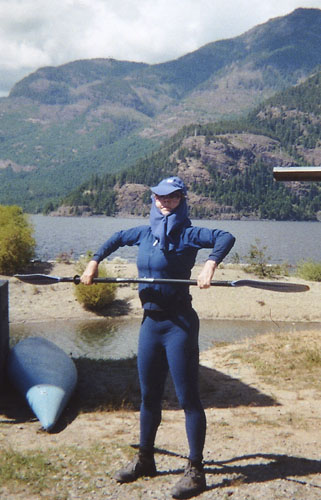 Before kayaking, warm up the rotator muscles of the shoulders.
Before kayaking, warm up the rotator muscles of the shoulders.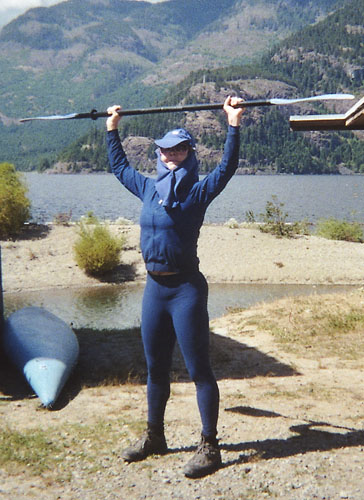
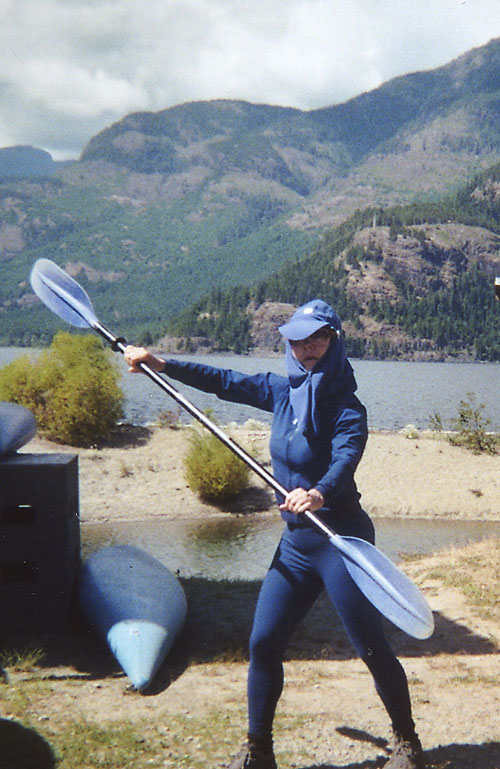 Warm-up the back with rotational movements before sitting down in the kayak.
Warm-up the back with rotational movements before sitting down in the kayak.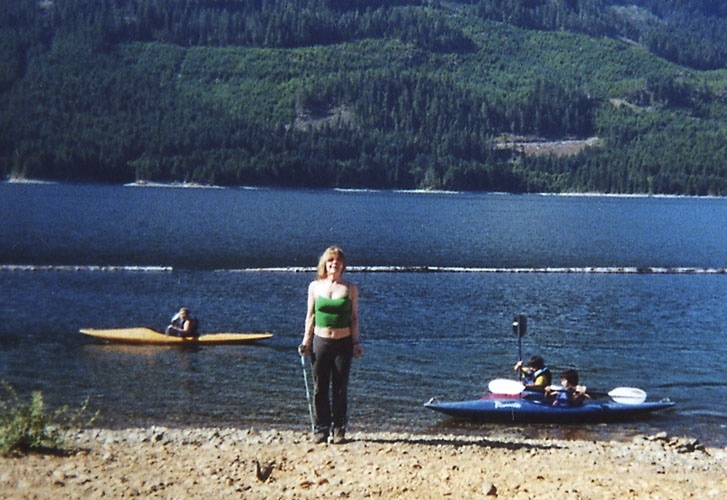 Remember to bring the EvergreenEnergy band on your trip to stretch afterwards.
Remember to bring the EvergreenEnergy band on your trip to stretch afterwards.
Ch09: Chores: The Lawn, The House, and the Driveway
Carve out a V-back as you cut the grass, blacktop the driveway, and paint the house.
Summer Chores Mowing the Lawn
Painting the House
Black-topping the Driveway
Tarring the Roof
The Pool
Level I can use the pool as their main summer exercise and as mentioned in the clinic it is one of the best ways of rehabilitating injuries. The water's buoyancy allows you to do things you can't do on land. The hydrostatic pressure forces the static fluid around the joints upwards towards the heart, easing swelling and inflammation.
Go to the water version of Knockout Ballet 'n Box for pool exercises.
Ch10: EvergreenEnergy™
Relax, breathe, and meditate with the EvergreenEnergy™ stretches.
Upper Body Stretches
Neck
Shoulders
Chest
Hands
Lower Body Stretches
Calf Stretch
Hamstring Stretches
Quad Stretches
Performance
When stretching, space and time can vary but lighten the effort. Learn to isolate muscles as much as possible, releasing and relaxing.
Back and Hip Stretches
Cat’s Cradle
Get on all fours like a cat but with your hands directly under your shoulders and your knees under your hips. Keep your spine parallel to the floor like a coffee table. As you exhale, contract your abdominals and turn your spine into a C-shape. As you inhale look up to the ceiling and arch your back like a cat in heat. Don’t guillotine your neck or pinch your low back.
Iliopsoas or Hip Flexor stretches
Piriformis Stretches or Butt Stretches sitting and lying
Spinal Twist Stretches
Full Body Stretches
Forward and Backward Bends
Circles, Side-bends and Spirals
Wall stretches: Standing: Gastrocnemius and Soleus Stretches. Quad Stretches, Standing Hamstring. Pec stretches against wall. Stand parallel to the wall. Place a hand on the wall with the arm straight slightly lower than shoulder level. Take a few steps away from the wall, gently twisting your body away from the wall till you feel a stretch.
Supine with legs on wall: Gluteus, Piriformis, Hampstrings
Sitting with back against wall: Groin stretch in butterfly position, heels together knees apart.
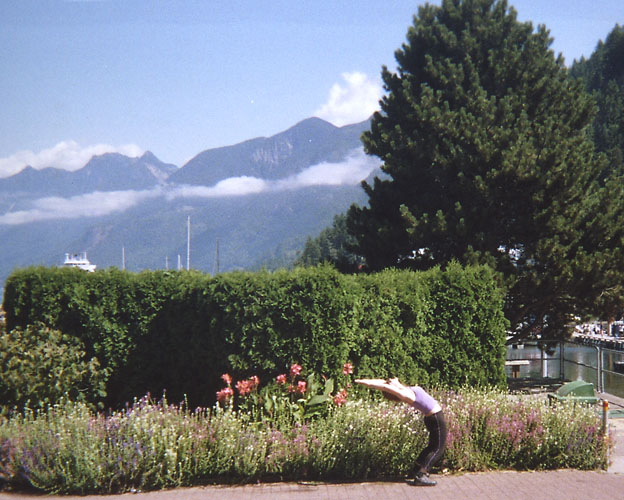 You can stretch anywhere any time.
You can stretch anywhere any time.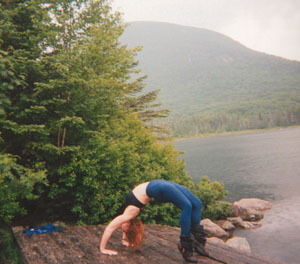
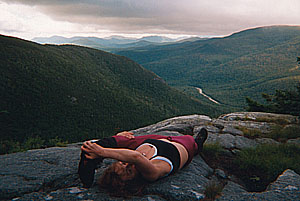 These are Level III stretches but everyone can do a little something. Listen to your body and relax into the stretch.
These are Level III stretches but everyone can do a little something. Listen to your body and relax into the stretch. 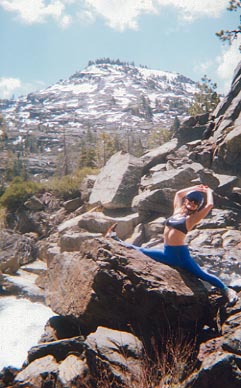
EVERGREENENERGY MASSAGE: EvergreenEnergy is also a massage system, using Swedish, Shiatsu, medical massage, and eco-massage to flush toxins, align energy centers, get rid of adhesions, improve muscular and joint function, enhance circulation, and relax and refresh the mind. Email julia.keefer@nyu.edu for more information on EvergreenEnergy MASSAGE.
Ch11: Mental/Spiritual
Focus on the water, taste, and smell centers as you improve your diet and your sensuality.
Ch12: Environmental
Give any way you can to environmental causes.
Come to the Happy Healthy Harvest!
KNOCKOUT STEP/SLIDE/STRIKE
KNOCKOUT BALLET 'N BOX
KNOCKOUT CARDIO-CORE with AEROBIC GUT AND BUTT
EVERGREENENERGY
Dr. Keefer's Corrective Clinic
 Dr. Julia Evergreen Keefer julia.keefer@nyu.edu
Dr. Julia Evergreen Keefer julia.keefer@nyu.edu 


 Do side steps, knee and leg lifts.
Do side steps, knee and leg lifts. 

 shock from getting stuck in an avalanche in the French alps, and Lyme disease from ticks in the Northeast. Take precautions. Check for ticks and adverse weather conditions. Drink lots of water, and eat regularly and plentifully. What is left of the wilderness is our most beautiful treasure.
shock from getting stuck in an avalanche in the French alps, and Lyme disease from ticks in the Northeast. Take precautions. Check for ticks and adverse weather conditions. Drink lots of water, and eat regularly and plentifully. What is left of the wilderness is our most beautiful treasure.

 Before kayaking, warm up the rotator muscles of the shoulders.
Before kayaking, warm up the rotator muscles of the shoulders.
 Warm-up the back with rotational movements before sitting down in the kayak.
Warm-up the back with rotational movements before sitting down in the kayak. Remember to bring the EvergreenEnergy band on your trip to stretch afterwards.
Remember to bring the EvergreenEnergy band on your trip to stretch afterwards.  You can stretch anywhere any time.
You can stretch anywhere any time.
 These are Level III stretches but everyone can do a little something. Listen to your body and relax into the stretch.
These are Level III stretches but everyone can do a little something. Listen to your body and relax into the stretch. 